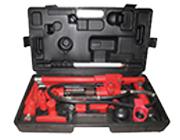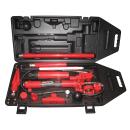Hydraulic press

Bodybuilder hydraulic press
︾
Bodywork hydraulic press: essential for your repair work
Hydraulic bodywork presses are essential equipment in the automotive repair sector, offering greater power and versatility for a variety of tasks. These robust tools harness hydraulic power to perform straightening, bending and forming operations with exceptional precision and efficiency. Let's delve into the world of hydraulic bodywork presses and explore their key features, applications and benefits.
Features of hydraulic body presses :
Adjustable press force :
In-body hydraulic presses offer adjustable press force, allowing users to adjust power to suit the specific needs of each operation.
Versatile work platens:
Featuring versatile work platens, these presses can accommodate a variety of workpiece shapes and sizes, offering maximum flexibility in straightening and forming applications.
Precise control:
Modern hydraulic systems are equipped with precise controls, allowing fine control of the pressing force. This ensures gentle handling during straightening and forming operations.
Robust structure:
The robust structure of these presses ensures maximum stability during operations, guaranteeing user safety and accurate results.
Versatile applications:
Hydraulic presses are versatile and can be used for a variety of applications, such as chassis straightening, sheet metal bending, dent removal, and other bodywork operations.
Bodywork hydraulic press applications :
Chassis straightening:
Hydraulic presses are used to straighten deformed or damaged chassis, restoring the structural integrity of vehicles.
Sheet metal forming :
They are ideal for sheet metal forming, whether to create specific parts or to adjust the shape of bodywork components.
Bodywork repair:
Straightening and forming operations carried out with hydraulic presses are commonly used for repairing bodywork damage, offering accurate and aesthetically pleasing results.
Dent removal:
Hydraulic presses are also used to remove dents from body panels, restoring the vehicle's original surface.
Alignment of parts :
They allow precise alignment of different body parts, guaranteeing perfect assembly and an aesthetic finish.
Advantages of hydraulic bodywork presses :
Precision and control:
Hydraulic technology offers a high level of precision and control, enabling delicate operations even in complex bodywork jobs.
Time saving:
Hydraulic presses allow tasks to be completed quickly and efficiently, reducing the time required for bodywork operations.
Versatility:
Versatility of application makes hydraulic presses a worthwhile investment for body shops, covering a wide range of repair needs.
Straightening efficiency:
For straightening work, these presses offer considerable force, making it easy to straighten deformed metal structures with precision.
Longevity and durability:
Hydraulic presses are generally built using robust materials, guaranteeing greater longevity and durability even under intensive conditions of use.
In conclusion, hydraulic bodywork presses are essential tools for automotive repair professionals, offering a combination of power, precision and versatility to meet the varied demands of bodywork operations. This equipment plays a key role in vehicle restoration and repair, ensuring high-quality results.
Your questions about the use of hydraulic presses in bodywork :
Hydraulic bodywork presses are essential tools in the arsenal of car repair professionals. These powerful pieces of equipment, based on hydraulic technology, offer a robust and versatile solution for a variety of straightening, forming and bodywork repair tasks. Users of hydraulic presses frequently ask key questions to understand the extent of their functionality and ensure optimum use. Let's explore some of the questions most commonly asked by users.
1. How does a bodywork hydraulic press work?
The fundamental question often concerns the operation of the hydraulic press. The answer explains the role of the hydraulic system in generating force to compress or expand the plates in the press, enabling straightening and forming operations.
2. What pressing capacity do I need for my workshop?
Users ask what the ideal press capacity is for their specific needs. The answer depends on the type of bodywork work frequently carried out, the size of the vehicles processed and the variety of operations envisaged.
3. What are the main applications for a hydraulic bodywork press?
Users are trying to understand the different possible applications. The answer highlights chassis straightening, sheet metal forming, dent removal and other bodywork repair operations.
4. What is the difference between a hydraulic press and other bodywork lifting tools?
Some users want to compare hydraulic presses with other bodywork lifting tools, such as jacks. The answer points to the greater power and versatility of hydraulic presses, which are specifically designed for forming and straightening operations.
5. What safety considerations should be taken into account when using a hydraulic press in bodywork?
Safety is a major concern. Users ask about built-in safety features, safe operating procedures and preventive maintenance to ensure risk-free operation.
6. Can a hydraulic press be used for all types of vehicle?
Some users ask whether a hydraulic press is suitable for all types of vehicle, from light cars to heavier vans. The answer underlines the diversity of pressing capacities and the need to choose a press suited to the anticipated loads.
7. What are the most important features to consider when buying a hydraulic bodywork press?
During the purchasing process, users ask questions about key features to consider, such as press capacity, platen size, precision of hydraulic controls and the reputation of the manufacturer.
8. How do I maintain a hydraulic press to ensure its durability?
Durability is a crucial factor. Users are looking for advice on regular maintenance, replacing worn parts and ensuring a long life for their investment.
In conclusion, the questions posed by users of hydraulic presses for bodywork applications reflect their search for in-depth information to ensure safe, efficient operation tailored to their specific needs. The questions also reflect users' awareness of the importance of choosing and maintaining this key piece of automotive repair equipment wisely.
